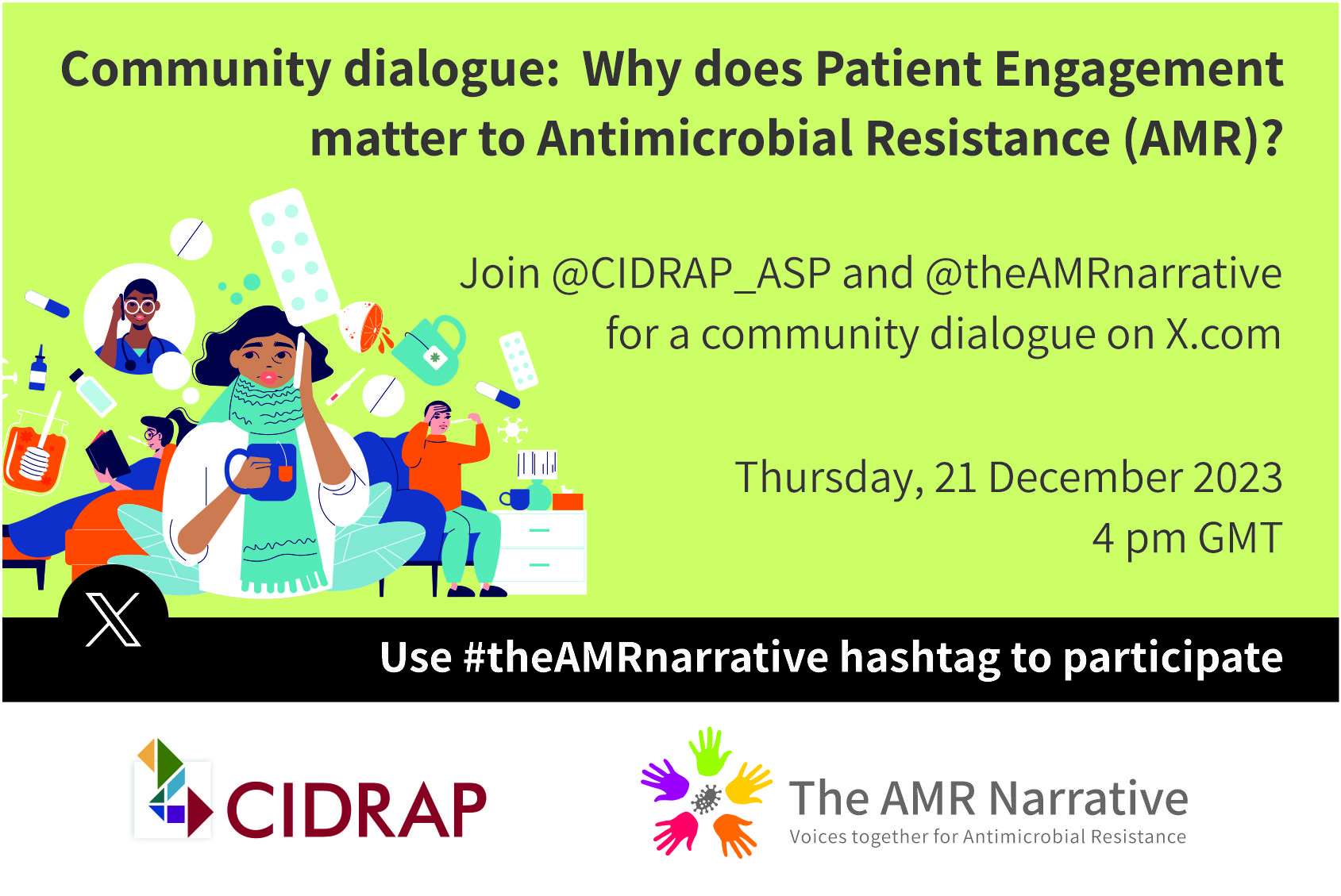December 21, 2023
Interactive chat on X: Why does Patient Engagement matter to Antimicrobial Resistance (AMR)?

Joining Details
Moderator: Natalie Vestin (@CIDRAP_ASP) and Vanessa Carter (@theAMRnarrative)
Date: 21 December 2023
Where: X.com (Previously Twitter)
Time: 4 pm GMT
Hashtag: #theAMRnarrative
——————————————————————————————————————————————————–
How to participate
Join us for a 60-minute community dialogue on X with our panel experts. Both panel experts and the public are encouraged to answer. Use the #theAMRnarrative hashtag in all your posts so that you are visible to others in the chat and captured on the transcript.
- The session will be in a text format.
- To join, login to X.com (Previously Twitter) and search for the hashtag #theAMRnarrative making sure to select “latest” in the top bar so that the stream of posts comes up. Refresh the latest posts again if you leave the stream and return.
- We start with introductions for the first few minutes. Tell us who you are and what you do.
- Questions will be prompted every 10 minutes. Start your answers with the relevant T and number and always end with the hashtag #theAMRnarrative
- The session can move quite quickly if many people take part, therefore we advise our guests to prepare answers in advance. The questions can be viewed above
- First and foremost, it’s the use of the hashtag that makes a dialogue like this work. Watch out for spelling mistakes and remember “the” – (i.e., #theAMRnarrative not #AMRnarrative)
——————————————————————————————————————————————————–
Overview
Patient engagement encompasses numerous activities such as shared decision-making, communication with healthcare providers, health education, involvement in research and healthcare policy discussions, and fostering a continuous and collaborative relationship between patients and the healthcare system.
Informed patients are empowered, and educating individuals about the consequences of AMR, the proper use of antimicrobials, and potential risks associated with inappropriate use can lead to improved decision-making. Patients who are aware of the impact of their actions are more likely to adhere to prescribed treatments and adopt preventive measures, thereby reducing the overall burden on AMR.
Open and transparent communication between patients and healthcare providers is also essential. Patients who feel at ease discussing their symptoms, asking questions about prescribed medications, and understanding the rationale behind antimicrobial prescriptions are more likely to adhere to treatment plans. This communication aids healthcare professionals in making more informed decisions and ensures judicious prescription of antimicrobial medicines.
Patients can actively engage in preventive measures that reduce the need for antimicrobials, like antibiotics. Simple practices such as maintaining good hand hygiene, getting vaccinated, and adopting a healthy lifestyle contribute to overall well-being and minimise the risk of infections. By focusing on prevention, patients play a proactive role in reducing the demand for antimicrobial medicines.
Patients are integral members of communities, and their influence extends beyond individual actions. Engaging with communities to raise awareness about AMR, participating in advocacy efforts, and supporting policies that promote responsible antibiotic use can have a significant impact. Patients, as advocates, can help shape a culture of collective responsibility towards antimicrobial stewardship.
On a global scale, patient engagement is essential, considering the cultural and regional variations in healthcare practices. Patients from diverse backgrounds bring unique perspectives to the table and involving them in initiatives to address AMR ensures that interventions are culturally sensitive and tailored to specific populations.
————————————————————————————————————————————————————
Questions
– Introductions first
T1: How would you describe Patient Engagement?
T2: What difference do you think Patient Engagement could make to Antimicrobial Resistance (AMR)?
T3: What are some of the barriers to Patient Engagement for Antimicrobial Resistance (AMR)?
T4: In what different ways can Patient Engagement extend beyond an individual level, for example to impact policy discussions or community mobilization?
CT: Any thoughts you would like to add about the role of Patient Engagement for Antimicrobial Resistance (AMR)?
Note: Prior to the event, review the University of Minnesota’s Social Media House Rules for a code of conduct applicable to this event.







